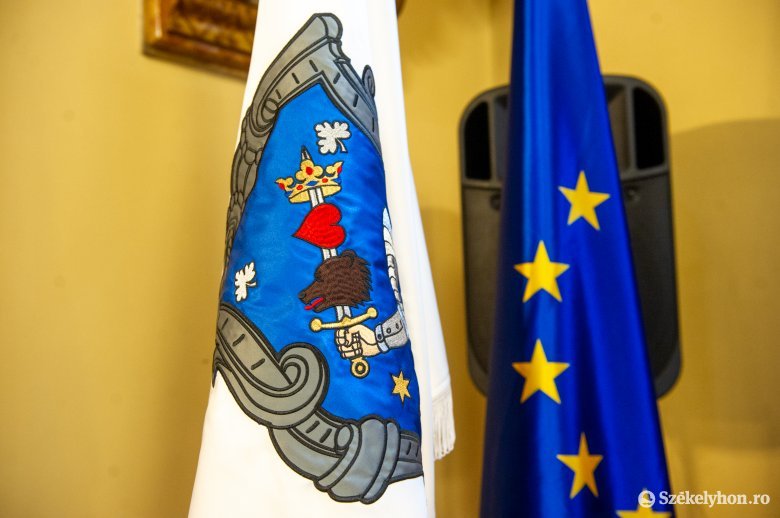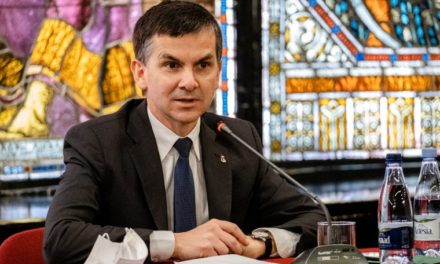Heraldist István Szekeres Attila considers it sad that people who have nothing to do with the coat of arms of Székelyudvarhely are attached to it. "It's like someone walking in from the street and telling the doctor not to take out the patient's spleen, but the liver," the expert explained to the Krónika in connection with the fact that the Bucharest Prosecutor General's Office initiated a procedure following a complaint by an animal protection organization in the matter of the symbol of the mother city of Székely.
As we wrote, the Supreme Prosecutor's Office launched an investigation into the coat of arms of Székelyudvarhely adopted last year, specifically because of the pierced bear's head appearing on the symbol. According to the suspicion expressed in the transcript delivered to the mayor's office, "the silver-colored blade piercing the head of a bear with closed eyes, which can be seen in the coat of arms, suggests a crime of cruelty to animals." We asked the heraldic opinion of Attila Szekeres István Szekeres in connection with the report and investigation, which caused a clash among many.
The president of the Transylvanian Coat of Arms and Flag Science Association told the Krónika that an animal protection association filed a complaint with the investigative authority, following which they requested documents and documentation from the Udvarhely municipality regarding the acceptance of the coat of arms.
He pointed out that this is a so-called in rem investigation, i.e. the suspect has not been named - so in fact everyone involved in the adoption of the coat of arms in any way is a suspect, i.e. starting with the person who initiated the adoption of the coat of arms, the members of the city council, the mayor, the county and zonal officials through the coat of arms inspection committee, the National Heraldic Society, the Ministry of Public Administration and the national Legislative Council, all the way to the government and the prime minister, since they also signed the decision on the adoption of the coat of arms.
"I would say that the accusation is ridiculous, but it is rather sad that people who have nothing to do with it are attached to a coat of arms. It's like someone walking in off the street and telling the doctor not to take out the patient's spleen, but the liver. Heraldry is a profession practiced by very few people in Romania. Anyone who doesn't understand it shouldn't have a say in it," stated the heraldist from Sepsiszentgyörgy.
In the coat of arms of Székelyudvarhely, an armored arm holding a sword appears, on which a bear's head, heart and crown are pierced.
According to István Attila Szekeres, this is an ancient symbol, it can be proven that it is more than half a millennium old, and it can also be proven that Székelyudvarhely has been using it as its coat of arms and seal for more than three hundred years. The coat of arms adopted last year was designed by János Mihály based on the ancient coat of arms - it is actually the original Székelyudvarhely coat of arms, without modifications.
The heraldist also touched on the fact that we can see similar symbols, killed or dead animals in several coats of arms. For example, in the second field of Romania's coat of arms, there is the symbol of Moldavia, which is a severed bull's head, or, for example, in the lower wedge, in the fifth field, in the coat of arms of Dobrudja, two dolphins "cast on dry ground", because they are not in water. Nyárádszereda's coat of arms adopted last year - designed by István Attila Szekeres based on the Bocskai coat of arms - features a lion with an arrow through its eye. The coat of arms of the Daniel family with a swan with an arrow through its neck appears in the symbol of the Vargyas settlement. The line could be continued or even supplemented by the fact that, although it does not appear in the coats of arms used today, there are plenty of historical coats of arms that show a Turkish or Tatar head impaled on a sword.
Let's leave history and symbols alone, don't get involved in historical symbols, let's leave it to those who understand!"
- concluded the expert.
In relation to the elements of the coats of arms, the heraldist also explained that the old coat of arms descriptions usually did not include what it symbolized - including in the case of Székelyudvarhely - an explanation can certainly only be given when, for example, a letter of donation described in detail what kind of coat of arms the monarch donated, in detail the meaning of the symbols. The symbolism of the coat of arms can be explained later on the basis of similar examples. "It can be said that the pierced heart is a symbol of self-sacrifice, in the same way as in the coat of arms of Háromszék or Kovászna counties. Marosvásárhely (Székelyvásárhely) was expanded in 1616 and can still be seen in its current coat of arms with a bear's head pierced by a sword. The bear's head is a symbol of courage, pierced or not," the herald explained.
István Szekeres Attila also said that the Transylvanian Coat of Arms and Flag Association plans to issue a statement in Romanian and Hungarian regarding the proceedings initiated in connection with the coat of arms of Székelyudvarhely, in the interest of clarity.
Source: kronikaonline.hu
Photo: szekelyhon.ro












